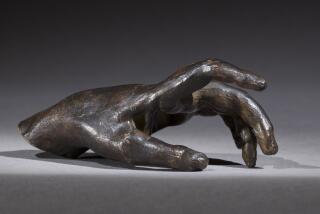Niki de Saint Phalle, 71; Artist Known for Large, Colorful Sculptures
- Share via
French-born artist Niki de Saint Phalle, who created a fantastic world of monumental female figures fondly known as “Nanas” and crafted vividly colorful sculptures that became popular landmarks in her native Paris and her adopted home in La Jolla, has died. She was 71.
She died Tuesday at Scripps Memorial Hospital in La Jolla of respiratory ailments after a long battle with emphysema and asthma.
“This is a sad loss for all of us,” said Mary Beebe, director of the Stuart Collection, a renowned public sculpture garden at UC San Diego. “Her generosity of spirit was enormous.”
Saint Phalle’s “Sun God,” a 14-foot-tall bird perched on a 15-foot-tall concrete arch, is “greatly beloved as the informal mascot for the university,” Beebe said. Installed on campus in 1983, the improbable creature was the first work commissioned by the Stuart Collection and the artist’s first large outdoor work in the United States.
While “Sun God” looms large in Southern California, a whimsical fountain of kinetic forms made by Saint Phalle and Swiss artist Jean Tinguely attracts visitors to a plaza near the Georges Pompidou Center in Paris. But these celebrated pieces are merely a sample of a huge body of work that ranges from stylized performances to sculptures of gigantic animals and bathing beauties.
Paul Schimmel, chief curator at the Museum of Contemporary Art in Los Angeles, recalled Saint Phalle as an influential artist who rose to prominence in the 1960s with “shooting paintings,” or “tirs,” made by using a rifle to shoot bags of pigment attached to papier-mache constructions or plaster panels.
“She was quite the catalyst,” he said, referring to performances in which Saint Phalle made her own form of “action painting” as she splattered paint and ripped canvas. But “the heart and soul of her work,” he said, is the “Tarot Garden,” a sculpture park in Garavicchio, Italy, near the Tuscan town of Orbetello. By far her most ambitious project, it consists of 22 monumental structures based on characters in the card game. “That’s her all-encompassing vision,” Schimmel said.
The artist was born Mary Agnes de Saint Phalle in 1930 in the wealthy Neuilly-sur-Seine suburb of Paris, the daughter of a French banker and his French American wife. The family moved to New York when she was 3, and she was raised in a privileged environment of private schools. As a budding artist in a traditional family, she married writer Harry Mathews, and had her first child, Laura. In search of a bohemian lifestyle, they moved to Mallorca, where their son, Philip, was born, then bummed around Europe for several years with the children.
At 25, Saint Phalle discovered the work of Barcelona architect Antonio Gaudi, whose organic buildings became the most dominant influence on her sculpture. About five years later, she left her husband and children to become a full-time artist. It was a traumatic period that “gave me wings as an artist,” she said, in a 1998 interview with The Times, noting that she enjoyed a warm relationship with her children despite the divorce.
On her own in Europe, Saint Phalle formed a friendship with Tinguely, which turned into a love affair and an artistic collaboration. They lived together for 11 years before marrying, in 1971. They separated two years later but maintained a close relationship until his death in 1991.
Saint Phalle moved from Paris to La Jolla in 1994 in hope of alleviating respiratory problems caused by inhaling fumes from petrochemicals and plastics used in her work. By then, she had compiled an international resume of exhibitions and collectors, but she became part of the Southern California art scene--taking part in local fund-raisers and exhibitions. The Mingei International Museum in San Diego staged a major show of her work in 1998.
She also maintained a presence in Europe. The Sprengel Museum in Hanover, Germany, which staged a retrospective of her work in 1981 and maintained a close association with her, has the world’s largest holding of her work--more than 350 sculptures, paintings, assemblages, drawings and prints.
A self-taught artist who functioned as something of an outsider, Saint Phalle seemed oblivious to the hierarchies and conventions of the art world. Although her early work is taken more seriously by critics than her popular, signature sculptures, she is one of relatively few women who are known for monumental sculpture.
“Most people don’t see the edginess in my work,” she told The Times. “They think it’s all fantasy and whimsy.”
The story behind the art is much more complicated than it looks, Saint Phalle said. Sculptures that depict black people and mixed-race couples convey her hopes for reducing racial tensions. Works that incorporate human skull forms grapple with death, and her animal sculptures can be rather ominous.
Most important, her trademark “Nanas”--often interpreted as exuberant celebrations of women’s freedom and power--evolved from a series of sculptures based on women’s roles in society, she said.
Admittedly independent and self-confident, Saint Phalle nonetheless had something to prove as an artist and as a woman.
“I wanted to make some of the really important things of my generation and some of the biggest,” she said. “I wanted to show that we were capable of doing more than needlework.”
Information on her survivors was not immediately available.
More to Read
The biggest entertainment stories
Get our big stories about Hollywood, film, television, music, arts, culture and more right in your inbox as soon as they publish.
You may occasionally receive promotional content from the Los Angeles Times.










